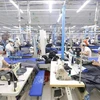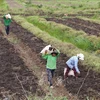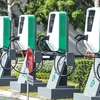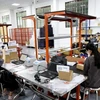Hanoi (VNA) – As the Russia-Ukraine conflict complicates, oil prices continue to 'escalate' and the world economy falls into crisis, it will be very difficult for Vietnam to achieve its GDP growth target of 5-6.5% this year.
All predictions revised down
According to the Organization for Economic Cooperation and Development (OECD), the conflict between Russia and Ukraine has created a major humanitarian crisis, affecting millions of people, and causing a severe economic shock and global instability. On that basis, the OECD forecasts that global growth in 2022 will be more than 1 percentage point lower than the 4.5% forecast made in December 2021.
Similarly, in its Global Economic Outlook report released on March 21, Fitch Ratings has cut its world GDP growth forecast for 2022 by 0.7pp to 3.5%, with the eurozone cut by 1.5pp to 3.0% and the US by 0.2pp to 3.5%. This reflects the drag from higher energy prices and a faster pace of US interest rate hikes than anticipated.
The World Monetary Fund (IMF) expects inflation in 2022 to continue to increase, at around 3.9% in developed countries and 5.9% in emerging markets and developing economies.
In response to concerns about inflation, the US Federal Reserve (FED) raised interest rates by 25 basis points (0.25%), reaching 0.5%, in order to reduce the rise in the consumer price index. It said it plans to increase six more times in 2022 with interest rates expected to reach 1.9% by the end of 2022.
17,100 businesses leave market per month
Domestically, a report of the General Statistics Office (GSO) said that in the first quarter of this year, Vietnam saw good growth in socio-economic picture in all fields in the context of the complicated development of the COVID-19 epidemic plus unpredictable world economic and political fluctuations.
The gross domestic product (GDP) in the first quarter increased by 5.03% over the same period last year, the industrial production index went up 6.4%, and the total realized investment capital in society rose by approx. 9%. Total export turnover of goods increased by nearly 13% and imports up by 16%, with a trade surplus of 809 million USD, while the average consumer price index was curbed at 1.92%.
According to economist Nguyen Tri Hieu, the economic growth rate of 5.03% is a high level compared to that of the region and the world. Statistics show that the macro economy continues to be stable and inflation is kept at an appropriate level. Besides, the manufacturing sector made a positive recovery, while domestic goods supply-demand was guaranteed. Indicators on the financial-money market also indicate that the banking sector has performed quite well, with credit growth reaching over 4% as compared to 1.47% in the same period last year.
However, the first quarter of the year saw 35,700 enterprises forced to temporarily suspend operations, a rise of 49.7% on-year, with 17,100 businesses withdrawing from the market every month on average.
During the three-month period, there were approximately 34,600 newly registered enterprises with a total registered capital of 471.2 trillion VND and 25,600 enterprises resuming operations, up 73.6% on-year.
According to Hieu, the world economic situation in 2022 tends to be more serious than the 2008 financial crisis. In a positive scenario, if the conflict between Russia and Ukraine calms down, the two sides reach an agreement and cease the war in the second quarter, the world economy will be more stable. Vietnam will see eased challenges in achieving the set targets of economic growth and inflation control.
“In case the conflict becomes complicated, oil prices continue to 'escalate' and the world economy falls into crisis, it will be very difficult for Vietnam to achieve its GDP growth target of 5-6.5% this year. The global economic situation strongly affects import-export activities as well as the supply chain of the country,” he predicted./.
























